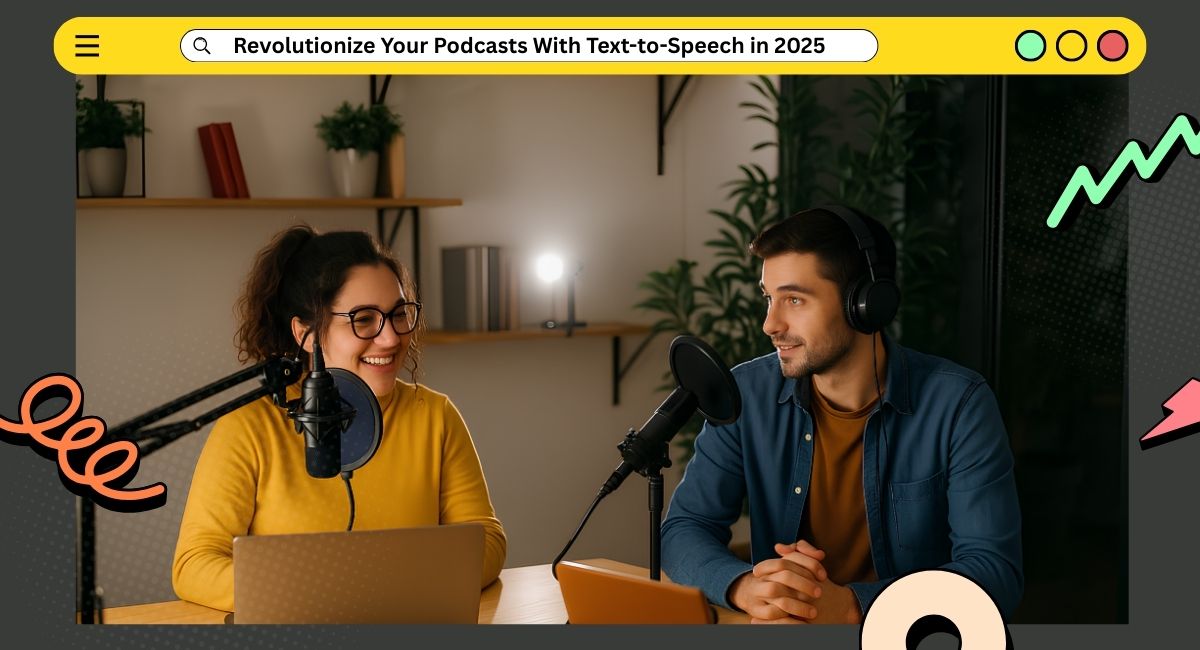The podcasting industry is booming. The number of podcast listeners worldwide is expected to reach 500 million by 2025. It’s a challenge for creators to keep up with this rapid growth and produce engaging episodes as quickly as possible.
Text-to-speech (TTS) technology is a powerful solution to this problem. Rather than spending hours recording or hiring expensive voice actors, TTS allows podcasters to transform written scripts into lifelike audio. A modern tool like Murf AI offers natural voices, multiple accents, and deep customization features that make storytelling more engaging.
Learn how text-to-speech can help you transform your podcasting journey and why creators should choose Murf.
Contents
Top Benefits of Podcast Text-to-Speech
Podcast text-to-speech offers far more than just convenience—it’s a productivity and creativity booster. Here are four key benefits:

Time-Savings
Recording an episode or hiring a voice actor can take hours, if not days. With TTS, you simply upload or type your script and generate professional-quality audio in minutes. This enables podcasters to:
- Release episodes more frequently.
- Stay ahead of schedule.
- Spend more time on content strategy instead of production.
Accessibility
TTS empowers creators to reach wider audiences, including listeners with dyslexia, visual impairments, or learning challenges. By offering content in natural spoken form, podcasters make their shows more inclusive and ensure no one is left behind.
Voice Variety
TTS unlocks a library of voices in multiple languages and accents, giving podcasters the flexibility to:
- Match voice style with content (soothing narration, authoritative news, animated storytelling).
- Add cultural authenticity with accents in English, Spanish, Portuguese, and more.
- Keep listeners engaged with dynamic and diverse tones.
Deep Customization
Unlike traditional recording, TTS lets you fine-tune every detail:
- Add emphasis to highlight important words.
- Adjust pitch and speed to match the mood.
- Insert pauses for natural rhythm and dramatic effect.
Together, these features create audio that feels personalized, human, and professional.
💡 Quick Fact
With AI-powered text-to-speech, podcasters can create episodes in minutes, save hours of recording, and engage listeners with lifelike voices in multiple languages and accents.
Elevate Your Podcasts With Murf
Among the growing number of TTS platforms, Murf AI stands out for podcasters. Here’s why:
✅ Natural-Sounding Speech
Murf’s voices undergo quality checks across dozens of parameters, ensuring they sound realistic and engaging. With over 100+ AI voices in 20 languages, you can easily create audio that feels authentic and emotionally resonant.
✅ Hundreds of Voices & Accents
Whether you need a warm, conversational tone or a professional newsreader style, Murf has it covered. You can select from a wide range of voices, including multiple English, Spanish, and Portuguese accents, helping you tailor audio to your audience’s cultural context.
✅ Advanced Customization
Murf gives podcasters control over every aspect of their narration:
- Emphasis: Stress key words or phrases.
- Pitch Control: Add emotional depth.
- Pauses: Improve pacing and flow.
This flexibility ensures that your podcast reflects your unique brand and storytelling style.
How to Create Podcasts With Murf: A Step-by-Step Guide
Creating a podcast with Murf is simple and efficient. Here’s how to do it in five steps:
1. Upload or Write Your Script – Add text, audio, or video into Murf Studio.
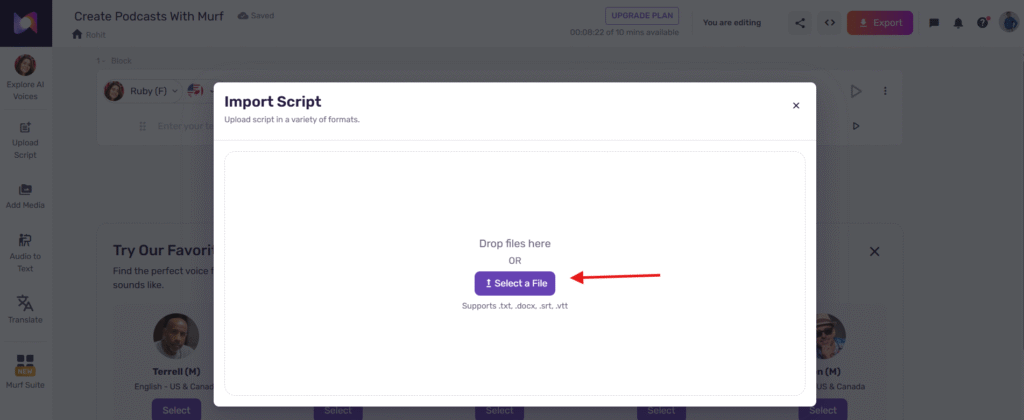
2. Choose a Voice – Browse the voice menu and select the AI voice that best fits your content.
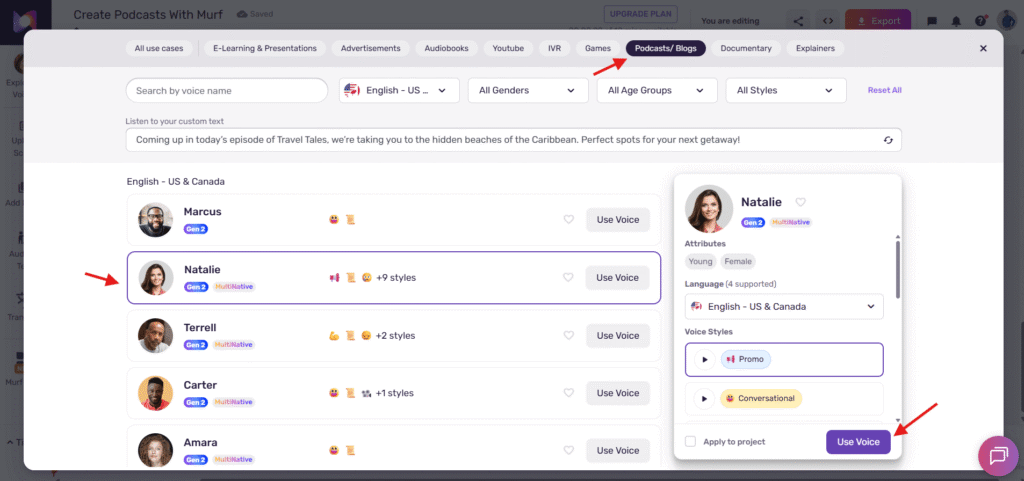
3. Customize – Use tools like emphasis, pitch, pauses, and pronunciation tweaks.
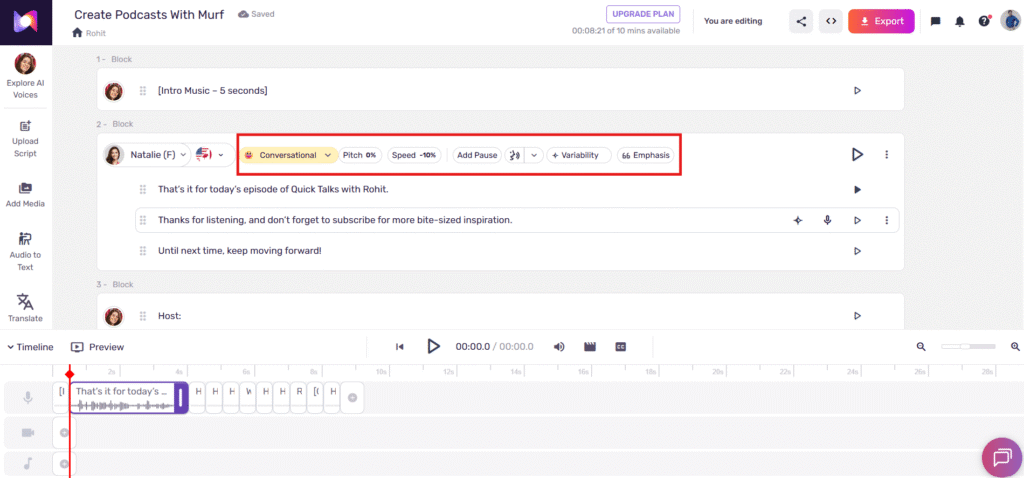
4. Add Music & Media – Enhance your podcast with royalty-free music, images, or video clips.
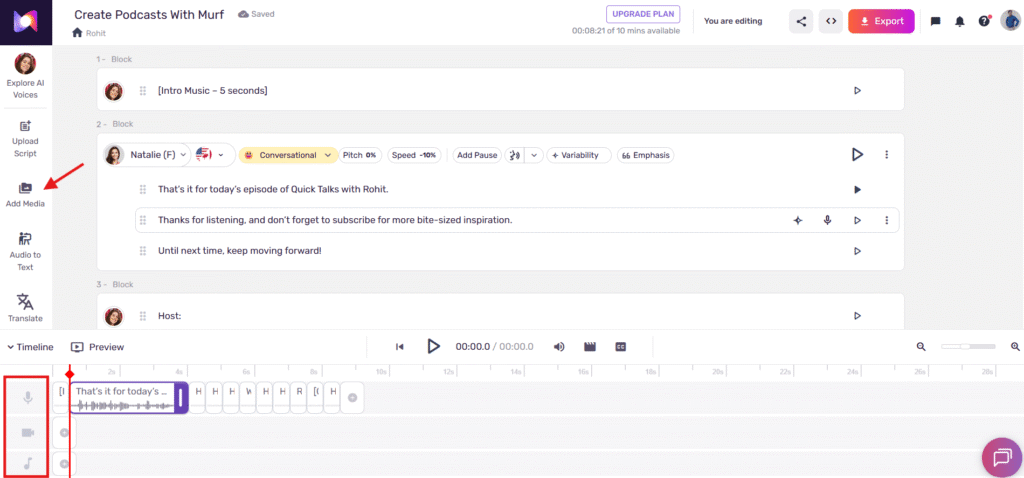
5. Render & Publish – Preview your podcast, finalize it, and export ready-to-publish audio.
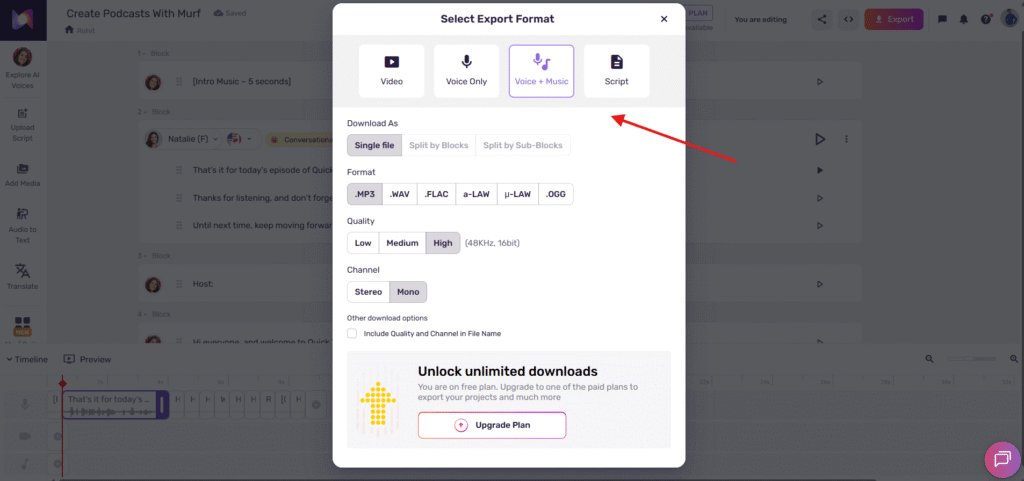
With this workflow, you can create a professional-grade podcast episode in less than an hour.
📌 Pro Tip
Consistently using AI voices in your podcast can improve listener engagement and help maintain a professional, polished sound across all episodes.
Transform Your Podcast With Murf’s AI Voice Technology
Podcasting is no longer limited to traditional recording. With Murf, creators gain:
- Authentic, human-like voices that keep listeners hooked.
- Multiple accents & languages for cultural relevance.
- Customization tools that let you shape content your way.
Whether you’re a solo creator or a large podcast studio, Murf makes it possible to produce studio-quality episodes at scale—quickly and affordably.
❓ Frequently Asked Questions
Q1: Can I use text-to-speech in podcasts?
Yes. TTS is widely used in podcasting to save time and ensure consistent quality. Murf even supports commercial use on paid plans.
Q2: Can a podcast have a script?
Absolutely. Most professional podcasts use scripts for structure. With TTS, your script becomes the foundation for natural-sounding narration.
Q3: How do I transcribe a podcast for free?
You can use free transcription tools like Otter.ai or Sonix, but Murf offers built-in text editing that works seamlessly with your audio.
Q4: Does Spotify transcribe podcasts?
Spotify automatically generates transcripts for some shows, but not all. For control and accuracy, podcasters often use external tools.
Q5: Is AI voice-over better than hiring a voice actor?
It depends on your needs. AI voices are faster, scalable, and cost-effective. Human actors may still offer more emotional nuance for storytelling-heavy shows.
5 Best Text-to-Speech Chrome Extensions.
Best Text-to-Speech Chrome Extensions to Boost Productivity in 2025
Final Thoughts
Text-to-speech is no longer a futuristic concept—it’s a practical tool that helps podcasters work smarter, reach wider audiences, and scale effortlessly. With Murf AI, you can create podcasts that are engaging, professional, and uniquely yours.
Rohit Kumar is a tech enthusiast and blogger who shares practical tips, insights, and reviews on AI, digital tools, and the latest technology trends.
